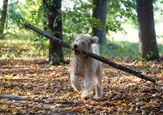If your kids have been begging for a dog and you’re finally ready for your family to grow by four paws, congratulations! It’s an exciting time. You are likely picturing happy afternoons together at the park, playful cuddles on the couch, and a pup who will grow with your family – especially with your child. But with so many dog breeds to choose from, finding the right fit can be overwhelming. You may have heard whispers of “the best dog breeds for kids.” Many online articles list Golden Retrievers, Labradors, and even some smaller breeds as the ideal family dog. While it’s true that these breeds are often friendly and playful, the truth is that the “best dog for kids” will depend on more than just the breed.In this guide, we will look at the most important factors and considerations when choosing your next family dog. Plus, we have collected some expert advice that may surprise you. Remember, the secret to finding the perfect dog for your family lies in research, careful consideration, and a commitment to doing right by both your children and your new pup. Debunking the Myth of the “Perfect” Family-Friendly Dog Breed While some breeds are better known for their family-friendly behavior traits, we must remember that every dog is an individual. Just like humans, dogs of the same breed may come with a wide range of personalities. Some may be more playful and tolerant of young children, while others may be more independent, nervous, or prone to anxiety. Furthermore, your dog’s personality isn’t solely based on their genetics. Much of a dog’s temperament is influenced by their upbringing. Proper socialization and training from a young age, regardless of the breed, can help your dog learn what behaviors you deem appropriate (especially around children). So, while some breeds are more likely to be a good fit in a family home, we must always remember that there is no guarantee! Factors to Consider When Choosing a Dog When deciding on your dog’s breed or the individual dog themselves, there are a few important factors to consider. This includes: Living Situation I firmly believe that a dog can thrive in just about any living situation given the right dedication from their humans, but choosing a dog that is well-suited for your situation will set you and your new dog up for success. Do you live in an apartment? A smaller, quieter (less barking), low-shedding dog breed may be a bitter fit than a larger, high-energy dog. If you have a house with a yard, you’ll have more space for an active pup to exercise and play. Other factors to consider include whether you have a fence (some dogs, like the Siberian Husky, are a bigger flight risk) and the amount of space within your home, especially if you’re considering a larger dog like a Great Dane. Family Lifestyle Does your family enjoy going for long hikes? Is there someone in your home who goes for a daily run and would love a dog interested in joining them? Or are you more of a couch potato bunch? Recognizing your family’s lifestyle will help you choose a dog breed that matches your vibe. A high-energy breed like the Border Collie is an excellent choice for an active household, but they may become bored or destructive if they aren’t getting enough exercise. On the other hand, a more relaxed and laid-back dog like the English Bulldog may struggle to keep up with the demands of a more active family. Your Child’s Age and Maturity LevelUp to this point, we have been talking about family-friendly dogs as if all children are created equally. But this clearly isn’t the case. The patience, understanding, and maturity of a 10-year-old child will be considerably different than that of a young toddler. Even within a specific age bracket, some children will be more mature and more willing to help with the dog than others. No one knows your child(ren) better than you. Take a moment to consider your child’s maturity level, personality, and specific needs in a dog. Commitment to Training and Socialization Training and socialization are essential for all breeds, but some dogs will likely need a little extra work to set them up for success in a home with kids. For example, a herding breed with natural herding instincts may be more tempted to wrangle your children. This may not seem problematic until you consider the fact that breeds like the Australian Cattle Dog herd livestock by nipping at their heels. When selecting a dog breed, consider how much time you’re willing and able to dedicate to their ongoing training and socialization. AllergiesIf anyone in your family suffers from allergies, including the extended family who often comes to visit, you may want to consider a hypoallergenic breed. The term is slightly misleading, as no dog breed is 100% allergy-free. However, dogs that are considered hypoallergenic generally shed less or produce less dander.

























